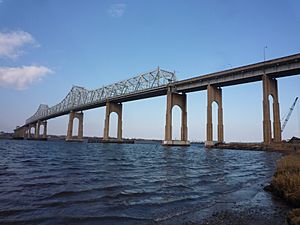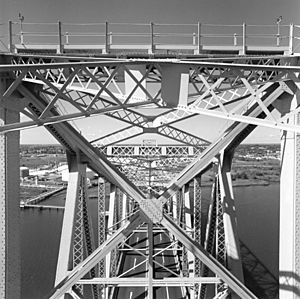Outerbridge Crossing facts for kids
Quick facts for kids Outerbridge Crossing |
|
|---|---|

Outerbridge Crossing looking northwest towards New Jersey.
|
|
| Coordinates | 40°31′30″N 74°14′49″W / 40.525°N 74.247°W |
| Carries | 4 lanes of |
| Crosses | Arthur Kill |
| Locale | Perth Amboy, New Jersey and Staten Island, New York |
| Maintained by | Port Authority of New York and New Jersey |
| Characteristics | |
| Design | Steel cantilever bridge |
| Total length | 8,800 feet (2,682 m) |
| Width | 62 feet (18.9 m) |
| Longest span | 750 feet (229 m) |
| Clearance above | 14 feet (4.3 m) |
| Clearance below | 143 feet (43.6 m) |
| History | |
| Opened | June 29, 1928 |
| Statistics | |
| Daily traffic | 77,107 (2016) |
| Toll | (Eastbound only) As of August 29, 2019:
|
The Outerbridge Crossing is a famous bridge that connects Perth Amboy, New Jersey, with Staten Island, New York. It crosses a waterway called the Arthur Kill. This bridge carries four lanes of traffic for New York State Route 440 and New Jersey Route 440.
The Outerbridge Crossing is one of three important bridges that link New Jersey and Staten Island. Like the other two, the Bayonne Bridge and the Goethals Bridge, it is managed by the Port Authority of New York and New Jersey.
Contents
Building the Outerbridge Crossing
Construction on the Outerbridge Crossing started in 1925 and finished in 1928. The bridge was named after Eugenius Harvey Outerbridge. He was the very first chairman of the Port of New York Authority, which is now called the Port Authority of New York and New Jersey. He also lived on Staten Island.
Even though it's called the "Outerbridge Crossing," some people mistakenly think it's named that because it's the farthest bridge in New York City. But it's actually just named after Mr. Outerbridge!
Bridge Design and Opening
The Outerbridge Crossing is a type of bridge called a steel cantilever bridge. This design uses strong arms that stick out from towers to support the roadway. It was designed by an engineer named John Alexander Low Waddell.
The bridge opened on June 29, 1928. This was the same day the first Goethals Bridge also opened. For many years, not many cars used these bridges. This was partly because of the Great Depression and World War II. Traffic only really picked up after the Verrazzano-Narrows Bridge opened in 1964.
Bridge Maintenance
Because so many cars use the Outerbridge Crossing every day, it needs a lot of repairs. For example, the entire bridge was repaved in 2013 to keep it smooth and safe for drivers.
Traffic on the Bridge
The Outerbridge Crossing is a very busy bridge. In 2006, about 32.4 million vehicles crossed it. That's roughly 90,000 vehicles every single day!
Paying to Cross (Tolls)
When you drive from New Jersey to New York City over the Outerbridge Crossing, you usually have to pay a toll. There is no toll if you are driving from New York City to New Jersey.
How Tolls Work
Today, tolls are collected using a system called open road tolling. This means there are no toll booths where you stop to pay cash. Instead, cameras are mounted on structures above the road on the Staten Island side.
- If you have an E-ZPass device in your car, sensors read it wirelessly, and the toll is paid automatically from your E-ZPass account.
- If you don't have E-ZPass, a picture of your license plate is taken. Then, a bill for the toll is mailed to the car's owner.
Toll History
Originally, tolls were collected in both directions on the bridge. But in August 1970, the toll for cars going west (towards New Jersey) was removed. At the same time, the toll for cars going east (towards New York City) was doubled. This change was made for many bridges in the New York-New Jersey area.
In 2005, special lanes were added for E-ZPass users. These lanes allow cars to go faster, up to 45 miles per hour, because they don't have to stop at a toll booth.


